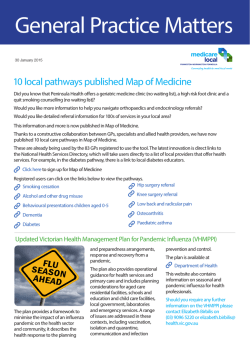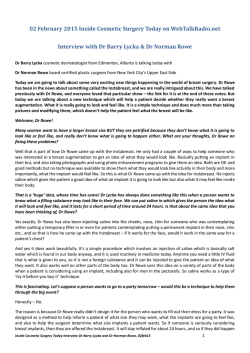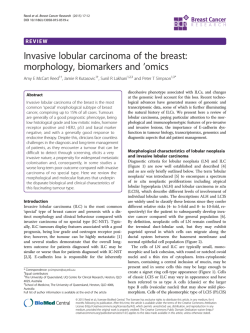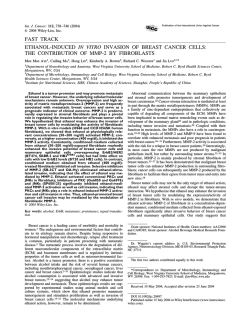
PDF (159 kB) - Clinical Breast Cancer
Table of Contents Volume 15, Number 1 February 2015 Illustration by Erin Moore Original Studies 1 Inflammatory Breast Cancer Management in the National Comprehensive Cancer Network: The Disease, Recurrence Pattern, and Outcome Jennifer M. Matro, Tianyu Li, Massimo Cristofanilli, Melissa E. Hughes, Rebecca A. Ottesen, Jane C. Weeks, Yu-Ning Wong IBC is a unique entity with aggressive clinical features, predictable recurrence patterns, and poor prognosis. The high rate of recurrence, especially in the CNS, suggests that new strategies for surveillance and follow-up are needed for earlier detection or prevention of brain metastases. 8 Ixabepilone Alone or With Cetuximab as First-Line Treatment for Advanced/Metastatic Triple-Negative Breast Cancer Olivier Trédan, Mario Campone, Jacek Jassem, Rostislav Vyzula, Bruno Coudert, Carmen Pacilio, Jana Prausova, Anne-Claire Hardy-Bessard, Ana Arance, Pralay Mukhopadhyay, Alessandra Aloe, Henri Roché Efficacy of ixabepilone (n ¼ 40), or ixabepilone with cetuximab (n ¼ 39), as first-line treatment for advanced/metastatic triple-negative breast cancer (TNBC) was assessed. Objective response rates of 30% and 35.9% were observed in the monotherapy and combination arms, respectively. Median progression-free survival was 4.1 months in both arms. Monotherapy and combination therapy demonstrated similar levels of activity, with predictable safety profiles. 16 Human Epidermal Growth Factor Receptor 2ePositive Breast Cancer: Heat Shock Protein 90 Overexpression, Ki67 Proliferative Index, and Topoisomerase II-a Co-amplification as Predictors of Pathologic Complete Response to Neoadjuvant Chemotherapy With Trastuzumab and Docetaxel Emilio Bria, Jenny Furlanetto, Luisa Carbognin, Matteo Brunelli, Chiara Caliolo, Rolando Nortilli, Francesco Massari, Serena Pedron, Erminia Manfrin, Francesca Pellini, Franco Bonetti, Isabella Sperduti, Giovanni Paolo Pollini, Aldo Scarpa, Giampaolo Tortora The correlation between Hsp90, Ki67, and TOPO2A and pCR was investigated in a series of 24 patients with HER2-positive breast cancer. Neoadjuvant trastuzumab-docetaxel significantly decreased Ki67, and pCR was significantly higher in patients with high Hsp90. These data suggest that Hsp90 may help to discriminate patients with HER2-positive breast cancer as potential candidates to achieve pCR when receiving anti-Her2 agents. 24 Long-Term Follow-Up After Preoperative Trastuzumab and Chemotherapy for HER2-Overexpressing Breast Cancer Erica L. Mayer, Adrienne B. Gropper, Lyndsay Harris, Julie M. Gold, Leroy Parker, Irene Kuter, Steven Come, Julie S. Najita, Hao Guo, Eric P. Winer, Harold J. Burstein Documentation of long-term outcomes following HER2-directed therapy is an emerging research area. We conducted a retrospective analysis of survival and toxicity outcomes using data from early trials of neoadjuvant trastuzumab with chemotherapy. We find that the association between pathologic complete response (pCR) and recurrence-free survival (RFS) persists at long-term follow-up, and that rare late cardiotoxicity might occur in patients re-treated with cardiotoxic agents. 31 High Pathologic Complete Response in Her2-Positive, Early-Stage Breast Cancer to a Novel Nonanthracycline Neoadjuvant Chemotherapy Amelia B. Zelnak, Petros Nikolinakos, Jayanthi Srinivasiah, William Jonas, Andrew Pippas, Yuan Liu, Xiaoxian Li, Mylin Torres, Ruth M. O’Regan, on behalf of the Georgia Center for Oncology Research and Education The incorporation of HER2-directed therapies into neoadjuvant treatment for early-stage, HER2-positive breast cancer has significantly improved the pathologic response rate. The combination of neoadjuvant nab-paclitaxel followed by vinorelbine in combination with trastuzumab was evaluated in this single-arm clinical trial. Among the 27 patients accrued, the pathologic complete response rate was 48.1%, demonstrating promising clinical activity. 37 Clinical Characteristics and Outcome of Bone-Only Metastasis in Inflammatory and Noninflammatory Breast Cancers Megumi Kai, Takahiro Kogawa, Diane D. Liu, Tamer M. Fouad, Kazuharu Kai, Naoki Niikura, Limin Hsu, Jie S. Willey, Richard L. Theriault, Vicente Valero, Naoto T. Ueno The clinical course of bone metastasis in inflammatory breast cancer (IBC) has not been well studied. This retrospective study analyzed 50 IBC and 147 non-IBC patients who had stage III disease on diagnosis of primary breast cancer and then developed bone-only metastasis at first recurrence. We found that the IBC group had a worse prognosis than did the non-IBC group. 43 Practice Patterns in the Delivery of Radiation Therapy After Mastectomy Among the University of California Athena Breast Health Network Jyoti Mayadev, John Einck, Sarah Elson, Hope Rugo, Shelley Hwang, Richard Bold, Parima Daroui, Susan McCloskey, Catheryn Yashar, Danny Kim, Barbara Fowble Practice patterns vary with the planning and delivery of radiation therapy after mastectomy (PMRT). We use a survey to investigate the role of bolus and a boost. Fifty-five percent of the respondents routinely use a boost to the chest wall in PMRT. Our study will help guide clinicians in the delivery of PMRT. 48 Everolimus-Induced Hematologic Changes in Patients With Metastatic Breast Cancer Amy Chen, Li Chen, Abeer Al-Qaisi, Edward Romond, Mukta Awasthi, Vera Kadamyan-Melkumyan, Suleiman Massarweh We report on hematologic toxicities encountered during a clinical trial using everolimus for metastatic breast cancer. Anemia, thrombocytopenia, and leukopenia were common but mild. Microcytosis and reduced red cell hemoglobin content were consistently observed during treatment. Although total white blood cell counts remained stable, there was a progressive decrease of lymphocyte percentage over time with a trend for increased neutrophils. 54 Second Cancer, Breast Cancer, and Cardiac Mortality in Stage T1aN0 Breast Cancer Patients With or Without External Beam Radiation Therapy: A National Registry Study Jason C. Ye, Weisi Yan, Paul Christos, Dattatreyudu Nori, Kun-San C. Chao, Akkamma Ravi The Surveillance, Epidemiology, and End Results (SEER) database was reviewed for long-term toxicities of radiation therapy (RT) in women with T1aN0 breast cancer (BC). No increase in cardiac or secondary cancer mortalities was found in patients who had RT, suggesting the rarity of these events. Women with early-stage BC eligible for breast conservation therapy should not be dissuaded based on the fear of late radiation toxicity. 60 Oral Ridaforolimus Plus Trastuzumab for Patients With HER2þ Trastuzumab-Refractory Metastatic Breast Cancer Milton Seiler, Isabelle Ray-Coquard, Bohuslav Melichar, Denise A. Yardley, Rui X. Wang, Pierre F. Dodion, Mark A. Lee Resistance to trastuzumab treatment is potentially mediated by aberrant phosphatidylinositide 3-kinase (PI3K)/AKT signaling; ridaforolimus may overcome trastuzumab resistance by inhibiting PI3K signaling. A single-arm phase IIb trial was conducted to evaluate the efficacy and safety of ridaforolimus-trastuzumab in such resistance in patients with human epidermal growth factor receptor 2epositive (HER2þ) trastuzumab-refractory metastatic breast cancer (MBC). The combination showed antitumor activity and may allow for combination with cytotoxic agents that could increase efficacy. 66 Breast Cancer Leptomeningeal Metastasis: The Results of Combined Treatment and the Comparison of Methotrexate and Liposomal Cytarabine As IntraeCerebrospinal Fluid Chemotherapy Anna Niwinska, Halina Rudnicka, Magdalena Murawska The aim of this study was to assess the outcome of 149 patients with breast cancer and leptomeningeal metastasis (LM) and to compare the efficacy of intrathecal methotrexate and liposomal cytarabine. Among treatment methods, only systemic therapy prolonged survival in these patients. Survival of patients treated intrathecally with methotrexate and those treated with liposomal cytarabine was comparable. 73 Comparison of Toxicity Experienced by Older Versus Younger Patients Enrolled in Breast Cancer Clinical Trials Caroline Mariano, Mia Francl, Janice Pope, Linda Wong, Howard J. Lim, Caroline Lohrisch The present study examined whether elderly patients who enroll in breast cancer clinical trials experience more toxicity than do younger patients. A total of 46 trials, including 799 patients, open at the British Columbia Cancer Agency (BCCA), Vancouver Center, were reviewed. Overall, the elderly patients did not experience increased toxicity; however, they were underrepresented in trials containing cytotoxic chemotherapy. Appropriate selection of elderly patients using eligibility criteria, self-selection, and/or clinician assessment will allow safe participation of elderly patients in breast cancer trials. 80 BRCAness Predicts Resistance to Taxane-Containing Regimens in Triple Negative Breast Cancer During Neoadjuvant Chemotherapy Sadako Akashi-Tanaka, Chie Watanabe, Tomoko Takamaru, Takashi Kuwayama, Murasaki Ikeda, Hiroto Ohyama, Miki Mori, Reiko Yoshida, Rikako Hashimoto, Sawada Terumasa, Katsutoshi Enokido, Yuko Hirota, Hiromi Okuyama, Seigo Nakamura We investigated BRCAness in the biopsy and surgical specimens from 73 patients with breast cancer, taken before and after taxane-containing neoadjuvant chemotherapy. All tumors that progressed on taxanecontaining regimens had a poor prognosis; all had BRCAness and most were triple negative. Identifying BRCAness can help predict the response to taxane-containing regimens. Available Exclusively Online at www.clinical-breast-cancer.com e1 Improved Clinical Outcomes Associated With Vitamin D Supplementation During Adjuvant Chemotherapy in Patients With HER2þ Nonmetastatic Breast Cancer Simon B. Zeichner, Tulay Koru-Sengul, Nikesh Shah, Qingyun Liu, Nathan J. Markward, Alberto J. Montero, Stefan Glück, Orlando Silva, Eugene R. Ahn Vitamin D (VD) supplementation has pleiotropic effects that extend beyond their impact on bone health, including the disruption of human epidermal growth factor receptor 2 (HER2) signaling through the ErbB2/AKT/ERK pathway. We performed a retrospective review of patients who received VD supplementation during neoadjuvant chemotherapy (n ¼ 134) and those who did not (n ¼ 112). In our final multivariate model, VD use was associated with improved disease-free survival (DFS) (hazard ratio [HR], 0.36; 95% confidence interval [CI], 0.15-0.88); P ¼ .026). To the best of our knowledge, our study is the first to report a significant improvement in DFS for patients who received VD supplementation concurrently with trastuzumab-based chemotherapy for HER2-positive (HER2þ) nonmetastatic breast cancer. e13 Association Between Ligands and Receptors Related to the Progression of Early Breast Cancer in Tumor Epithelial and Stromal Cells Vivian Labovsky, Leandro Marcelo Martinez, Kevin Mauro Davies, Hernán García-Rivello, María de Luján Calcagno, Ayelén Matas, Valeria Beatriz Fernández Vallone, Alejandra Wernicke, Hosoon Choi, Norma Alejandra Chasseing We have demonstrated the association between RANKL, IL-6, SDF-1, and CCL-2 in tumor epithelial cells and their receptors in spindle-shaped stromal cells, as well as between TRAIL, RANKL, and CCL-2 in spindle-shaped stromal cells and their receptors in tumor epithelial cells from 63 patients with breast cancer (I/II stage). These molecules may be implicated in breast cancer progression during the early stage of the disease. e23 Significance of Fine Needle Aspiration Cytology and Vacuum-Assisted Core Needle Biopsy for Small Breast Lesions Satoko Nakano, Masahiko Otsuka, Akemi Mibu, Toshinori Oinuma Of 455 ultrasonography-guided vacuum-assisted core needle biopsy (VAB) cases of small breast lesions, fine-needle aspiration cytology (FNAC) was performed before VAB in 248 cases [54.5%] yielding inconclusive results in 133 cases [53.6%]. Excisional biopsy was performed in 17 benign VAB cases, because of FNAC overdiagnosis in 6 cases [35%]. Pathological, not cytological, examination should be the initial diagnostic approach. e27 Chemotherapy Use and Surgical Treatment by Receptor Subtype in Node-Negative T1a and T1b Female Breast Cancers, Iowa SEER Registry, 2010- to 2012 Mary C. Schroeder, Charles F. Lynch, Taher Abu-Hejleh, Elizabeth A. Chrischilles, Alexandra Thomas Small node-negative breast tumors represent a growing portion of breast cancer diagnoses. As treatment recommendations have evolved for this group, we report the first SEER data on chemotherapy and surgical choice by breast cancer receptor subtype for these tumors. In Iowa from 2010 to 2012, chemotherapy use correlated with recurrence risk for the 1687 women included. Relatively high rates of mastectomy were seen. e35 Variability in Measuring the Ki-67 Labeling Index in Patients With Breast Cancer Shinya Yamamoto, Takashi Chishima, Yuka Mastubara, Shouko Adachi, Fumi Harada, Youko Toda, Hitoshi Arioka, Naoki Hasegawa, Yukio Kakuta, Kentaro Sakamaki The aim of the present study was to evaluate the Ki-67 labeling index variability using different measurement methods and specimens. The results differed according to the method and specimen types used, and the indication for chemotherapy also changed accordingly. e41 Cysteine Rhenium Colloid: A Novel Radiocolloid for Identifying Sentinel Lymph Nodes in Breast Cancer Surgery Biniam Kidane, Pamela L. Zabel, Vaibhav Gupta, Caroline Whiston, Frances Wright, Muriel Brackstone Cysteine rhenium colloid (CRC) requires less medical isotope than standard sulfur colloid (SC) for sentinel lymph node biopsy (SNB). Our retrospective cohort study on 1205 consecutive early, clinically node-negative breast cancer patients who underwent SNB with either isotope suggests CRC is an alternative to SC in detecting sentinel lymph nodes, and uses less medical isotope. e47 The Oncologic Safety and Practicality of Breast Conservation Surgery in Large Breast Tumors 5 Centimeters or More Conor M. Sugrue, Peadar S. Waters, Karl J. Sweeney, Carmel Malone, Kevin Barry, Michael J. Kerin The surgical management of large breast cancers is controversial. Improvements in neoadjuvant chemotherapy along with utilisation of oncoplastic surgical techniques have enabled breast conservation in women with larger breast cancers. This study demonstrates oncologic equivalence of BCS and mastectomy for tumors 5 cms. The re-excision was higher in this cohort in comparison to smaller tumors in other studies. Extensive DCIS was a risk factor for inadequate margins. e55 Effects of Second and Subsequent Lines of Chemotherapy for Metastatic Breast Cancer In Hae Park, Keun Seok Lee, Jungsil Ro Continuing cytotoxic chemotherapy is justified in metastatic breast cancer. However, the clinical effects of successive treatment have not been evaluated. In the present study, we assessed 240 patients with metastatic breast cancer who received multiple lines of cytotoxic chemotherapy regimens. We confirmed that the beneficial effects of subsequent chemotherapy for patients with a durable response from previous treatment. e63 Invasive Lobular Carcinoma Arising in a Hamartoma of the Breast: A Case Report Julie Lambert, Naim Jerjir, Jan Casselman, Luc Steyaert e67 Breast Cancer in Male-to-Female Transgender Patients: A Case for Caution Maryam Sattari e71 Breast Cancer in a RAD51D Mutation Carrier: Case Report and Review of the Literature Jennifer L. Baker, Richard B. Schwab, Anne M. Wallace, Lisa Madlensky e77 Papulopustular Acneiform Eruptions Resulting From Trastuzumab, a HER2 Inhibitor Johanna Sheu, Elena B. Hawryluk, Georgia Litsas, Manisha Thakuria, Nicole R. LeBoeuf
© Copyright 2025





